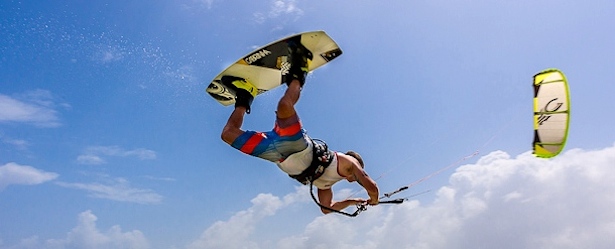
The warm waters once home to so many pirate ships are now home to a new breed form of fringe activity. The sails remain yet the ship is now a surfboard. It’s called kitesurfing (or kiteboarding), and the Caribbean has established itself as one of the best places on the planet to partake in the thrilling surface water sport. A combination of windsurfing and wakeboarding, kitesurfing is an entirely self-sustainable individual sport, which is to say its fuelled on wind power and adrenaline. Which, one could argue, is probably what a lot of pirate ships were fuelled on, too. That and rum. Oh, and conquest. But kitesurfing is a form of conquest – man vs self and man vs nature, the ultimate challenges to overcome. Albeit in a much less violent manner than the pirates of yesteryear.
We’re calling kitesurfing a new sport but realistically it’s been around for ages. Way back in the 1800s folks were experimenting with kite-propelled transportation, or kitepower, for land carts and small boats. The patent for kitesurfing was granted in 1977 but it took many years and attempts to perfect the technology (such as inflatable tube kites). It wasn’t until the late ’90s that it became popularized as an extreme sport with the help of legendary big wave surfer Laird Hamilton in Hawaii. In the early 21st century the single-direction board became largely replaced with a twin-tip board. Kitesurfing has yet to enter the Summer Olympics but lobbying groups are pushing for its inclusion at the 2020 games.
Before we get into how it works let’s look at some world records. The fastest speed ever recorded on a kiteboard is 55 knots (just over 100 km/h). The longest distance ever traveled on a kiteboard in one go is as astounding 537 km along the coast of Portugal. Hypothetically speaking you can go as long as the wind holds or until you pass out from exhaustion, whichever comes first. The previous longest recorded kite journey (before this next gem) is 2,000 km between Salvador and Sao Luis, Brazil, which took 24 days to complete. But just a few months ago at the end of 2013, a team of kitesurfers smashed that record.
Between November 20th and December 17th, 2013, six kitesurfers crossed the entire Atlantic Ocean. They started in the Canary Islands and ended in none other than our Turks and Caicos Islands. That’s 5,600 km (3,500 miles). They split the ride into several multi-hour sessions, surfing both by day and night. What a feat. And what better place to celebrate their record-breaking achievement than the Caribbean kitesurfing mecca of Turks and Caicos.
So basically how it works is you bring your board and kite down to the beach, inflate your kite, harnessed onto your chest, and manoeuvre it up to catch the wind. Once you’ve got your big bright kite adrift and floating there high above you, walk down into the water and strap on your board. From the seated ready position, with your hands gripping the tow rope handle, you position it into the gust, stand up and ride on. Once you’re up you’re UP. Catch air by building up tension on your edges and releasing off of a wave and you can experience controlled flying. Five to ten second air time isn’t unusual and the record is 22 seconds.

The ideal conditions are somewhere with consistently steady side-onshore winds. In the Caribbean, the windy season is between December and mid-April, with winds blowing 10-25 knot range. Grenadines, BVIs, Turks and Caicos, and Bermuda are all primo spots for kitesurfing.
Grenadines: largely undiscovered in the kite realm = lots of room to play. stoke the atlantic side for wave riding or hit the protected coves rivaling the blue lagoon for flat water rips. the best launch areas are on the north and south coasts of the islands. especially solid areas like st george, st vincent, and carriacou.
British Virgin Islands: grab the best of everything here with the ultimate laidback lifestyle mixed with amazing kiting around towering islands through kool-aid blue waters. charter a catamaran with some friends and sa
il around to all the best spots.
Turks and Caicos: enormous launching room off the white sand beaches and 90% of the year with kiteable winds. kite around the rock iguanas and off grace bay beach for easy launching and access. follow the barrier reef for epic downwinders.
Bermuda: there are four primary launch zones in bermuda with both flat reef-lined coves and big wave kitesurfing offshore. watch out for man o’war jellyfish and rent a private boat to get you out to the very best spots.


